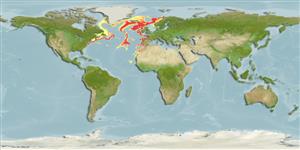Classification / Names
Common names from other countries
Main reference
Size / Weight / Age
Max length : 151 cm TL male/unsexed; (Ref. 108708); common length : 70.0 cm SL male/unsexed; (Ref. 3698); max. published weight: 0.00 g
Length at first maturity
Lm 111.6 range ? - 117.5 cm
Environment
Marine; bathypelagic; oceanodromous (Ref. 108735); depth range 200 - 2300 m (Ref. 108733), usually 700 - 1300 m (Ref. 108735)
Climate / Range
Deep-water, preferred 10°C (Ref. 107945); 71°N - 23°S, 82°W - 17°E (Ref. 6181)
Distribution
Short description
Dorsal
spines
(total): 34 - 41;
Dorsal
soft rays
(total): 52-56;
Anal
spines: 2;
Anal
soft rays: 43 - 48;
Vertebrae: 97 - 100. Body is extremely elongated, with body depth 10.8 to 13.4 times in SL. The snout is large with strong fang-like teeth. Pelvic fins represented by a single spine in juveniles but entirely absent in adults. Color is coppery black with iridescent tint. The inside of the mouth and gill cavities black.
IUCN Red List Status (Ref. 115185)
Threat to humans
Harmless
Human uses
Fisheries: highly commercial
More information
ReferencesAquacultureAquaculture profileStrainsGeneticsAllele frequenciesHeritabilityDiseasesProcessingMass conversion
Tools
Special reports
Download XML
Internet sources
Estimates of some properties based on models
Phylogenetic diversity index
PD50 = 0.5078 many relatives (e.g. carps) 0.5 - 2.0 few relatives (e.g. lungfishes)
Trophic Level
4.5 ±0.77 se; Based on food items.
Resilience
Low, minimum population doubling time 4.5 - 14 years (K=0.11-0.25, tmax=14)
Vulnerability
High vulnerability (64 of 100)
Price category
